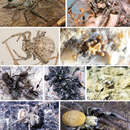Description
provided by Zookeys
Male (Nengrahar, Afghanistan, MR010, MR): Carapace with numerous white setae, cephalic region subtriangular, longer than wide, strongly raised; AME nearly as large as PME (AME/PME 0.88), median eyes separated on horizontal axis, largely overlapping on vertical axis; ALE on small tubercles; PER much narrower than AER (PER/AER 0.62), PLE position on carapace 0.24; clypeal hood forms acute angle; fovea shallow. Chelicerae with lateral boss, excavated mesally. Legs with numerous white setae; leg I distinctly thickened and elongated (contra Kraus and Kraus 1988: 232), without thick brush of setae; with distal ventral macrosetae on tibia I–IV, row of distal ventral macrosetae on metatarsus I–IV plus scattered ventral macrosetae on metatarsus and tarsus I–IV. Abdomen with numerous white setae (Figs 11A, B, 79A–D).
Male palp with proximal-distal axis; tegulum subtrapezoidal; conductor and embolus together form apical complex making one helical turn; conductor with more or less membranous and papilliated inner layer extending beyond moderately sclerotized outer layer; tegular division slightly longer than embolic division; cymbium with several prolateral macrosetae (Figs 15D–F, 79I, J, 80A–D).
Female (Belkis, Turkey, MR015, MR): Carapace with numerous white setae, cephalic region subtriangular, longer than wide, moderately raised; AME nearly as large as PME (AME/PME 0.87), median eyes separated on horizontal axis, largely overlapping on vertical axis; ALE on small tubercles; PER much narrower than AER (PER/AER 0.68), PLE position on carapace 0.21; clypeal hood forms acute angle; fovea shallow. Chelicerae contiguous mesally, with lateral boss. Legs with numerous white setae, with pair of distal ventral macrosetae on tibia I–IV and row of distal ventral macrosetae on metatarsus I–IV plus scattered ventral macrosetae on metatarsus and tarsus I–IV. Abdomen with numerous white setae (Figs 11C, D, 79E–H, 81A–F).
Epigynum with converging slit-like atria occupying nearly the total length, anteriomedian part with weak notch-shaped invagination, anteriolateral margin a strong curved ridge (Figs 18G, 82A). Vulva with spermathecal heads on thick sinuous stalks leading to multilobed spermathecae posteriorly (Figs 18J, 82B–D).
- license
- cc-by-3.0
- copyright
- Jeremy A. Miller, Charles E. Griswold, Nikolaj Scharff, Milan Řezáč, Tamás Szűts, Mohammad Marhabaie
- bibliographic citation
- Miller J, Griswold C, Scharff N, Řezáč M, Szűts T, Marhabaie M (2012) The velvet spiders: an atlas of the Eresidae (Arachnida, Araneae) ZooKeys 195: 1–144
- author
- Jeremy A. Miller
- author
- Charles E. Griswold
- author
- Nikolaj Scharff
- author
- Milan Řezáč
- author
- Tamás Szűts
- author
- Mohammad Marhabaie

